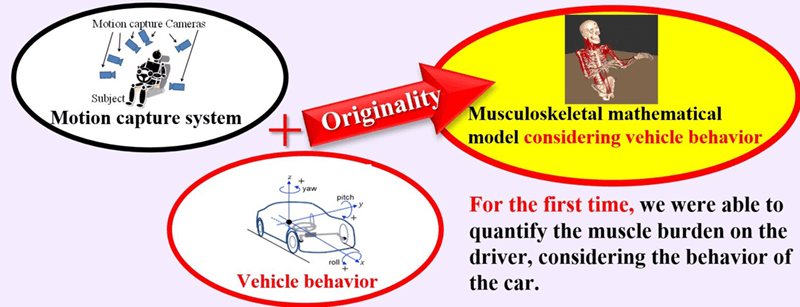 Open Access
Open Access
ARTICLE
Quantification of Ride Comfort Using Musculoskeletal Mathematical Model Considering Vehicle Behavior
1 Graduate Student, Graduate School of Industrial Technology, Nihon University, Chiba, 275-8575, Japan
2 Hitachi Astemo, Ltd., Tochigi, 321-3325, Japan
3 Former Graduate Student, Graduate School of Industrial Technology, Nihon University, Chiba, 275-8575, Japan
4 College of Industrial Technology, Nihon University, Chiba, 275-8575, Japan
* Corresponding Author: Kazuhito Misaji. Email:
(This article belongs to the Special Issue: Computer Methods in Bio-mechanics and Biomedical Engineering)
Computer Modeling in Engineering & Sciences 2023, 135(3), 2287-2306. https://doi.org/10.32604/cmes.2023.022432
Received 17 March 2022; Accepted 13 July 2022; Issue published 23 November 2022
Abstract
This research aims to quantify driver ride comfort due to changes in damper characteristics between comfort mode and sport mode, considering the vehicle’s inertial behavior. The comfort of riding in an automobile has been evaluated in recent years on the basis of a subjective sensory evaluation given by the driver. However, reflecting driving sensations in design work to improve ride comfort is abstract in nature and difficult to express theoretically. Therefore, we evaluated the human body’s effects while driving scientifically by quantifying the driver’s behavior while operating the steering wheel and the behavior of the automobile while in motion using physical quantities. To this end, we collected driver and vehicle data using a motion capture system and vehicle CAN and IMU sensors. We also constructed a three-dimensional musculoskeletal mathematical model to simulate driver movements and calculate the power and amount of energy per unit of time used for driving the joints and muscles of the human body. Here, we used comfort mode and sport mode to compare damper characteristics in terms of hardness. In comfort mode, damper characteristics are soft and steering stability is mild, but vibration from the road is not easily transmitted to the driver making for a lighter load on the driver. In sport mode, on the other hand, damper characteristics are hard and steering stability is comparatively better. Still, vibration from the road is easily transmitted to the driver, which makes it easy for a load to be placed on the driver. As a result of this comparison, it was found that a load was most likely to be applied to the driver’s neck. This result in relation to the neck joint can therefore be treated as an objective measure for quantifying ride comfort.Graphic Abstract

Keywords
Cite This Article
 Copyright © 2023 The Author(s). Published by Tech Science Press.
Copyright © 2023 The Author(s). Published by Tech Science Press.This work is licensed under a Creative Commons Attribution 4.0 International License , which permits unrestricted use, distribution, and reproduction in any medium, provided the original work is properly cited.


 Submit a Paper
Submit a Paper Propose a Special lssue
Propose a Special lssue View Full Text
View Full Text Download PDF
Download PDF Downloads
Downloads
 Citation Tools
Citation Tools
